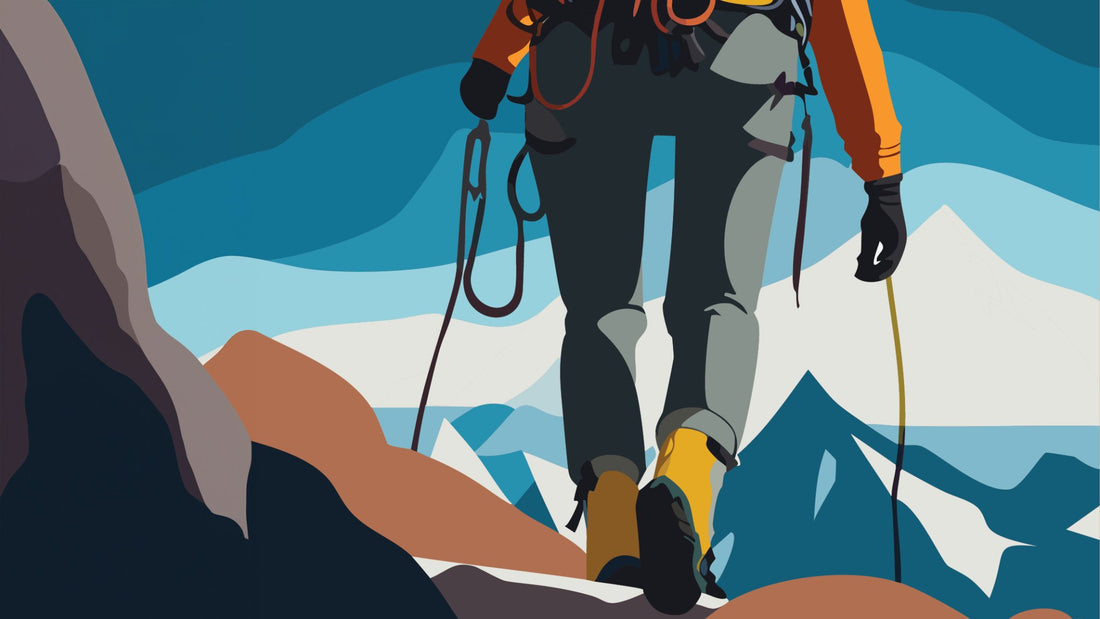
Layering systems for your legs
Share
People often focus on what to wear on their upper body but spare a thought for your poor legs. They do all the hard work carrying you around, so why should they get less attention?
Your legs also act as a thermostat for your feet. Chances are, if your legs aren’t warm enough then your feet are freezing.
Here’s our guide to legwear for extended trips to the mountains, from sea level to summit.
Walk in/Approach:
Depending on where you are headed, there’s likely to be at least some walking at a lower altitude and in warmer temperatures before you reach your intended climb. In the Alps that might be a sunny valley start at 25°C, or in Nepal a cool temperature in the morning that heats up as the day wears on. If you’re on a multiday trip and needing to pack light, then versatility is your friend. As are light weight fabrics you can wash by hand and dry overnight. Be warned, anything with high spandex or elastane content (>10%) will take longer to dry; many athletic leggings fall into this category. This is one of the reasons we use Polartec Power Stretch® Pro™ in our Thermal Power leggings, as they hold on to less moisture and dry faster.
The key to staying comfortable is to regulate your temperature, avoiding getting too hot or too cold. For days where there’s a lot of variation, pants that zip off into shorts can be a game changer, or zips on your trousers to aid ventilation. Some people find looser fit legwear which allows air flow is more comfortable, whereas others prefer a tight fit legging for the freedom of movement. Whichever you pick, you want something that will wick moisture away from your skin to help keep you cool and dry. If it’s really hot, a lightweight pair of running shorts might be all you need. These can double as sleep wear if you’re staying in a stuffy hut bunk room.
At basecamp:
If you’re camping at the base of your climb for more than a night, then you’re likely going to spend a fair bit of time sat in tents and hanging around camp. Even if temperatures aren’t that low, it’s easy to get cold when you’re not moving around that much. Having some warm, comfortable legwear will make life a lot more enjoyable. Some fleece leggings or joggers can double as your sleeping wear and camp lounge wear, saving weight and space in your pack.
Insulated pants can make a huge difference if you’re sat around at close to freezing in a tent eating dinner. It might feel like overkill but wearing them will also help keep your feet warm, which is always a challenge in a drafty mess tent!
On the mountain:
Just like your upper body, when you reach higher elevations and experience more variations in temperature you’ll need to start employing a layering system for your legs.
Start off with a baselayer that moves moisture away from your skin. Baselayers can also be worn alone if it’s warm enough lower down the mountain, and even double as your sleep wear higher up. Some people swear by merino wool for it's temperature regulation and anti-odour properties, while others prefer synthetic fleece fabrics as they move moisture better and are gentler on the skin.
Add a softshell pant on top of your baselayer that will cut the wind, deal well with abrasion, fit over your boots and provide storage for on-the-go items. If you’re not wearing a jacket then pockets on your legwear are handy for storing snacks, suncream etc.
If the weather is wet add a waterproof layer over the top; this can double as a windproof layer even if it’s not raining. You’ll want full length zips that allow you to get them on/off without removing your boots, and they can also give you the option to ventilate.
For cold days, where you’re moving slowly due to altitude (e.g. a high pass) or on a summit push, you’ll want some insulated pants for your legs. Make sure they fit over your boots (or inside the integrated gaiters if you prefer). When in camp, insulating pants are a game changer. They help keep your feet warm, not to mention your butt!
For summit day, if you have a warm enough insulating layer you can dispense with one or more of the layers you may have worn lower down the mountain and leave them at your high camp. The fewer layers you have to put on, the quicker it is to get dressed in a cramped tent, and it will make moving easier (as more layers create more friction).
Remember, the more layers you are wearing the more you must deal with during bathroom breaks. Have a strategy for how you’re going to manage that on the mountain: go before you start and work out how to undo your layers with your harness on before you need to do it in anger. (Check out our How to pee in the mountains blog here). In an ideal world all your layers work together to make it quicker (and safer) to go when you need to.
So, there you have it; look after your legs with a decent layering system and they will look after you in the mountains.
